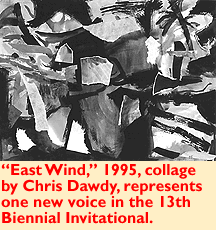A YEAR AGO the painter Will Saunders showed his familiar, meticulously constructed painted collages in a one-person show at the Tucson Museum of Art. Last week at Dinnerware, he let loose a surprising wild side in the form of three unruly drawings.
The three ink-on-paper pieces he contributed to the gallery's 13th Biennial Invitational are major departures for Saunders. Not only is their subject matter figurative--their three fierce heads make a decided contrast to his usual geometric abstractions--but the new works reflect the kind of fast, loose work that is everything his controlled paintings are not.
Each of the rapidly drawn heads has a primitive, almost scary look. "Improvisation (Female Head)" is a profile of a woman baring her teeth, her hand raised up to shield her face. "Improvisation (Male Head)" is a head-on face that wears a look of sheer terror. These quick studies, drawn more or less according to the Surrealist practice of Automatism, tap into the proverbial unconscious. They are more psychologically fraught than anything this artist has yet shown us.
That's the beauty of this free-wheeling show, for which Dinnerware members invite non-member artists to exhibit. A more-or-less established Tucson artist like Saunders feels free enough to put out new work, and unheralded newcomers get a chance to show their stuff alongside artists who are further along in their careers. This time around in the every-other-year show, there are only a handful of familiar names: Besides Saunders, there's Cristina Cardenas, another alumna of the TMA one-person Directions shows, Rene Verdugo, Gonzalo Espinosa, Rudolph M. Nadler and Joseph Labate.
Verdugo, like Saunders, has embarked in a whole new direction. Last time I caught his work, several years ago at Pima Community College, he was painting large, colored abstractions of such flatness they almost had the look of photographs or silkscreens. The new mixed-media works are polar opposites of those paintings. The only thing that's stayed the same is the intensity of Verdugo's colors. But even these are layered so thickly and roughly that they look like another material, maybe a mixture of foam pellets and pigments. And Verdugo is a long way away from the austerity of his former abstractions. In both pieces in the Dinnerware show he's attached large, and I mean large, found objects to the works.
 "Reindeer," for instance, incorporates five lawn deer,
the kind of mass-produced ceramic lawn sculptures that get respect
only at holiday time. The five deer, a mom and four kids, are
painted in the same thick, screaming salmon pink that covers the
background. "Madonna de las Islas" is a memento mori
of a more sober bent. Against its electric blue background, it
collects together objects reminiscent of the lost woman it commemorates:
a shiny, bright-red shirt, bouquets of pink cloth roses, and a
big, dead piece of desert wood that houses a tiny artificial bird.
"Reindeer," for instance, incorporates five lawn deer,
the kind of mass-produced ceramic lawn sculptures that get respect
only at holiday time. The five deer, a mom and four kids, are
painted in the same thick, screaming salmon pink that covers the
background. "Madonna de las Islas" is a memento mori
of a more sober bent. Against its electric blue background, it
collects together objects reminiscent of the lost woman it commemorates:
a shiny, bright-red shirt, bouquets of pink cloth roses, and a
big, dead piece of desert wood that houses a tiny artificial bird.
The pop-culture elements of these new works challenge the high-art conventions within which Verdugo has worked in the past. And surprisingly, especially in the "Madonna," they have an intense emotional impact. It will be interesting to see where Verdugo goes with them. By contrast, photographer Labate is still in an austere phase, continuing to experiment with multiple images of singular, portentous objects like flashlights and glass globes. Labate's found a niche here, but somehow I miss his old, oddly surreal photographs that offered weird glimpses of Old Pueblo life, at the Titan Missile Museum and crowded swimming pools.
Cardenas continues in her Mexican vein, this time showing "Malinche Coyolxaqui," a painting on bark of a dismembered goddess. Ornamented with painted skulls and snakes, ceramic roses and hearts, this work is an intriguing stop on Cardenas' continuing journey to forge a modern mixed media art that remains true to ancient Mexican aesthetics.
Among the newcomers, Bill Blomquist shows some promise with his semi-abstracted paintings of twisted cloth set against vaguely architectural backgrounds. Gary Swimmer is another painter with interesting soft-edged colors; he plays around with the effects of changing squares of colors set against each other, as does Marsha Goldberg, palely, with somewhat less success.
Sculptor Lori Wolverton has contributed a huge cast floor piece all in white. "Cheat" has a female body, its upper half encased in a funnel, looking down a sort of bowling alley filled with more than a dozen cast heads, presumably the woman's rivals. Tracy Lisk goes monumental with a gigantic yellow fresco screen, "Toy Box," a work so new it still bears the egg smell of her tempera colors.
Susan Rider draws on children's art to make three small prints and one painting of some emotional power. Children's drawings often seem like messages from the unconscious, with weird, strange shapes generated by the raw human mind before socializing civilization sets in. Interestingly, the face of the figure in her oil-on-canvas painting "The Explanation" is almost identical to the one in Saunders' "Improvisation (Female Head)," with the same profile, same gritted teeth, same wild hair. Arrived at in Saunders' case by self-imposed "automatic drawing," and in Rider's case presumably by imitation of a child's work, in both cases it's a powerful rendering of archetypal human anxiety.





